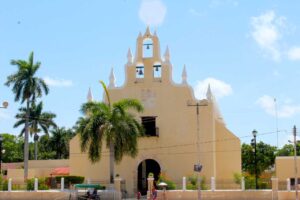If you are looking for a unique and unforgettable experience, the Convent Route in Yucatán is the best option. This route will take you to the most beautiful convents and monasteries built during the colonial era. You will be able to admire the architecture and history of these places, as well as enjoy the natural beauty of the region. We invite you to follow this route and discover the hidden treasures of Yucatán.
From Yucatán to Michoacán, there are several convent routes in Mexico. All were built in the 16th century and survive as examples of the ‘spiritual conquest’. In 124, the Franciscan friars arrived and settled in the territories of the present-day states of Hidalgo, Puebla, Michoacán and Yucatán. They quickly identified the Yucatán peninsula, a territory densely populated by the Maya. The evangelizing vigour was such that Merida is the only city in Mexico whose cathedral was built entirely in the 16th century, but beyond the capital, large convents were also erected across the peninsula.
Former Convent of San Bernardino de Siena – Valladolid

This is one of the oldest and most important colonial complexes in the state. It was founded around 1552 -the second one built in Latin America-; since then, the construction of the church and the cloister began.
Its exterior is notable for the series of battlements crowning the walls and the long arches reminiscent of medieval fortresses; inside, there is a remarkable Baroque altarpiece. In the garden there is a waterwheel raised over the Cenote Sis-há from which pre-Columbian and viceroyalty pieces have been extracted and are exhibited in the convent itself.
Convent of San Antonio de Padua – Izamal

It has the largest enclosed atrium in America and the second largest in the world, after St. Peter’s Basilica in Rome. It is built on the pre-Hispanic foundation of an important Mayan sanctuary dedicated to the cult of Itzamná, formerly known as the House of the Heads and the Lightning. It was visited in 1993 by His Holiness Pope John Paul II, marking his only visit to Yucatan.
Ex Convent Of San Antonio De Padua – Tekit

Known as “lugar del derramamiento” in pre-Hispanic times, this place belonged to the Maní de Tutul Xiú chiefdom and was one of the most important towns. It is known for the manufacture of typical Yucatecan regional costumes such as guayaberas, filipinas, hipiles and embroidered blouses. It is located south of Merida, near the archaeological zone of Mayap. Among its tourist attractions you will find: the ex-convent of San Antonio de Padua, built in the XVI century, and the chapel of San Cristobal.
Convent of San Francisco de Asis – Oxkutzkab

Oxkutzcab is well known in the state to produce sweet oranges, also known among the Yucatecans as “La China”. The geographical position of Oxkutzcab is privileged as it is located 7 km from the Loltun Caves and only 20 minutes from Uxmal. The Convent of San Francisco de Asis is of Tuscan style, it has a simple smooth but very beautiful façade, in the choir window it has some small carved stone details that adorn it, the figures are a carved cross, two crowned lions, two finials and the figures of the sun and the moon, a little further up we can see the figure of San Francisco de Asis to whom this church was dedicated and that next to him can be appreciated 3 belfries in which bells were once placed.
Ex-Convent and Parish of San Antonio de Padua -Ticul

Thanks to its remarkable beauty, this site has earned the nickname of La Perla del Sur (The Pearl of the South). Its parish was built because of the quests undertaken by Fray Diego de Landa to evangelise the settlers. The façade of the church is simple, but it has details that make it look beautiful, its smooth walls with small irregular stones cover it completely, at the entrance there is a large wooden door in which the frame has two sets of masonry columns, each one holding the figures of San Antonio de Padua.
Convent of the Virgin of the Assumption – Muna

Muna “Place of soft or tender water”, head of the municipality of the same name. In pre-Hispanic times it belonged to the “Tutul Xiu” chiefdom and after the conquest it remained under the regime of the encomiendas of Don Alonzo Rosado in 1700. The church in honour of the Virgin of the Assumption, in the municipality of Muna (in the south of the state), began to be built on May 11, 1691, according to the inscription inside the temple, which dates to the end of the 17th century, when the convent was extended to build the sanctuary, the cloister and the corridors.
.

Maní deserves special mention, which in its time housed the largest of the Mayan chiefdoms and was therefore the place chosen by the Franciscans to build the first permanent convent complex in the entire peninsula in 1549.
It is also interesting to note that several of these convents are higher than the rest of the buildings surrounding them, and this is because they were built on top of ancient pyramids.